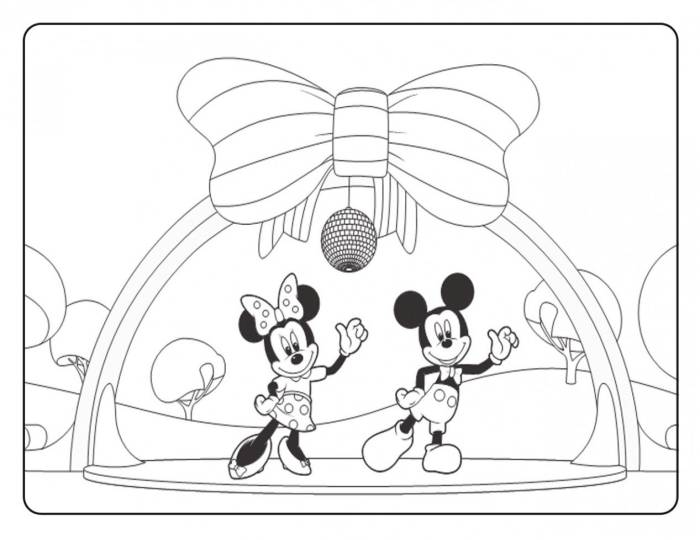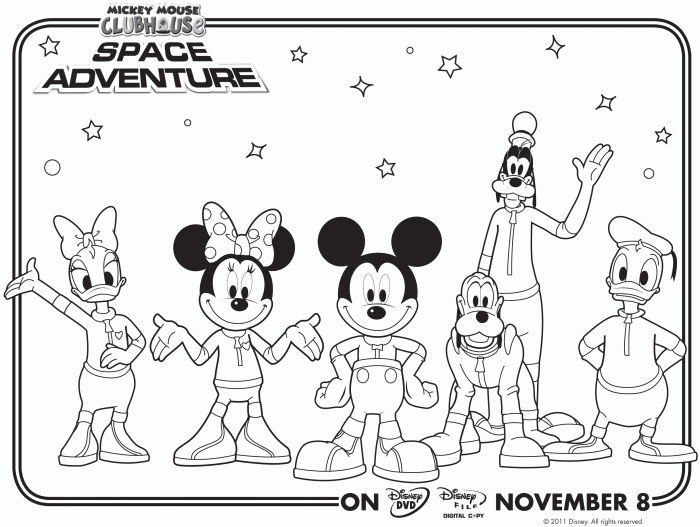Market Analysis of “Mickey Mouse Clubhouse Coloring Book”

This analysis explores the market potential of a “Mickey Mouse Clubhouse Coloring Book,” considering its target audience, competitive landscape, and effective marketing strategies. We’ll delve into the key factors that will contribute to its success in a crowded market.
Target Audience
The primary target audience is children aged 2-6 years old, particularly those who are fans of Mickey Mouse and his Clubhouse friends. Parents and grandparents represent a secondary target audience, as they are the primary purchasers of such products. This demographic is highly receptive to familiar characters and engaging activities like coloring. The book’s design should appeal to both the child’s desire for fun and the parent’s need for educational and entertaining activities.
Key Competitors and Comparative Analysis
Three key competitors in the children’s coloring book market include: “Disney Princess Coloring Book,” “Paw Patrol Coloring Book,” and “Peppa Pig Coloring Book.” These books, like the proposed Mickey Mouse Clubhouse Coloring Book, leverage popular children’s characters. Pricing typically ranges from £4-£8 depending on the page count, size, and additional features (e.g., stickers). Features vary, but generally include high-quality paper, vibrant illustrations, and age-appropriate designs.
A competitive advantage for the Mickey Mouse Clubhouse Coloring Book could be its focus on specific storylines or characters from the show, offering a unique selling proposition compared to broader character-based coloring books.
Marketing Channels
Marketing channels should leverage both online and offline strategies. Online channels include targeted advertising on social media platforms frequented by parents (e.g., Facebook, Instagram), collaborations with parenting bloggers and influencers, and strategic partnerships with online retailers like Amazon and eBay. Offline channels include placement in major toy retailers (e.g., Toys R Us, Smyths Toys), supermarkets with dedicated children’s sections, and independent book shops.
Strategic placement within Disney stores would also be highly beneficial.
Promotional Strategies
Several promotional strategies could boost sales. Discounts, such as a “buy one get one half price” offer, could incentivize purchases, especially during peak seasons like Christmas and birthdays. Bundling the coloring book with other Mickey Mouse Clubhouse merchandise (e.g., crayons, stickers, or a small toy) could create a more attractive package for consumers. Furthermore, limited-edition versions with special features (e.g., foil accents or glow-in-the-dark pages) could generate excitement and higher demand.
Running contests and giveaways on social media could also drive engagement and brand awareness.
The Mickey Mouse Clubhouse coloring book offers a delightful array of characters and scenes for young artists. Expanding the possibilities, one might consider supplementing the book with additional images sourced from online resources such as a comprehensive collection of coloring book clip art , which provides a wider variety of images to enhance the coloring experience. This allows for creative expansion beyond the book’s pre-printed pages, enriching the overall activity and providing further opportunities for artistic expression within the Mickey Mouse Clubhouse theme.
Illustrations and Visual Style

This Mickey Mouse Clubhouse coloring book needs a vibrant, engaging visual style that perfectly captures the spirit of the show. Think bright, bold colours and a design that’s playful yet detailed enough to hold a child’s attention. The illustrations should be instantly recognisable as Mickey Mouse Clubhouse, echoing the show’s established aesthetic.The overall artistic style will be undeniably cartoonish, employing the classic Disney style with a slightly simplified approach to make it easy for children to colour.
The characters should be expressive and friendly, inviting little ones to engage with the pages. We’re aiming for a style that’s both nostalgic and fresh, appealing to both long-time fans and new generations.
Color Palette
The color palette will be bright and cheerful, using primary colors extensively. Think bold reds, yellows, blues, and greens, with accents of purples, oranges, and pinks. We should incorporate a range of shades and tones within each color to add depth and visual interest, avoiding flat, one-dimensional colours. The background colours will generally be lighter and more pastel to allow the characters and main objects to pop.
Think about using a slightly desaturated version of the main colors for background elements to avoid overwhelming the page. This will ensure that the coloring experience remains visually stimulating without being jarring or overwhelming.
Line Weight and Texture
The line art will feature a medium line weight, thick enough to be easily seen and traced by small hands but not so thick that it overpowers the image. The lines will be clean and smooth, with a consistent weight throughout, avoiding variations that might confuse young colorists. The texture will be smooth, with no additional shading or stippling in the line art itself.
This ensures that the coloring process is straightforward and allows children to focus on filling the shapes with color. The clean lines will also provide a clear structure for the coloring, making it easier for children to stay within the lines.
Character Descriptions
Three key characters from the show, and their typical visual attributes, are essential to the book’s success.Mickey Mouse: Mickey is instantly recognisable with his large, round ears, circular head, and simple, friendly features. He usually wears his iconic red shorts and yellow shoes, and his body is typically depicted in a simple, almost cylindrical shape. His expression is typically cheerful and playful.Minnie Mouse: Minnie shares a similar style to Mickey, with large, round ears and simple features.
She usually wears a red polka-dot dress, yellow shoes, and a large, red bow. Her features are slightly softer than Mickey’s, giving her a more delicate appearance. Her expression is usually sweet and friendly.Pluto: Pluto is a playful and expressive dog. He’s a yellow-brownish color with floppy ears, a long tail, and a simple body shape. He has large, expressive eyes and a wide, open mouth, which is often depicted in a playful, happy expression.
His body is typically drawn in a more fluid and less rigid way than Mickey and Minnie, highlighting his energetic personality.
Educational Aspects and Value Proposition: Mickey Mouse Clubhouse Coloring Book
This Mickey Mouse Clubhouse coloring book isn’t just a fun activity; it’s a sneaky way to boost a youngin’s development, proper. It’s all about combining entertainment with educational benefits, making learning feel less like a chore and more like a playground adventure. This means parents and educators can chill knowing they’re providing valuable learning experiences, wrapped up in a package that’s seriously appealing to little ones.This coloring book offers a multitude of benefits for young children, going beyond simple entertainment.
It cleverly blends fun with learning, making it a valuable tool for both home and educational settings. The design encourages active participation, fostering a positive attitude towards learning from a young age.
Key Learning Benefits, Mickey mouse clubhouse coloring book
The coloring book provides several key learning benefits for children. Firstly, it enhances colour recognition and understanding. Kids learn to identify and differentiate between various colours while associating them with familiar characters and objects from the Mickey Mouse Clubhouse universe. Secondly, it improves hand-eye coordination. The act of staying within the lines and controlling the coloring tools strengthens fine motor skills crucial for future writing and drawing abilities.
Finally, it boosts vocabulary and storytelling skills. The familiar characters and scenes inspire imaginative play and conversations, expanding a child’s language and narrative capabilities.
Promoting Creativity and Fine Motor Skills
The open-ended nature of coloring allows for boundless creativity. Children aren’t just filling in pre-defined spaces; they’re actively shaping the visuals, experimenting with colour combinations, and expressing their own unique styles. The detailed illustrations provide a framework, but leave ample room for personal interpretation and artistic expression. The act of coloring itself directly strengthens fine motor skills. Holding crayons or pencils, controlling pressure, and staying within the lines all contribute to the development of hand-eye coordination, dexterity, and precision – all essential skills for later writing and drawing.
Incorporation into Educational Settings
This coloring book is a perfect fit for preschools and early years settings. It can be integrated into various learning activities, such as themed lessons on colours, shapes, or even storytelling. Teachers can use the book as a reward system, a calming activity during transitions, or as a springboard for discussions about the Mickey Mouse Clubhouse characters and their adventures.
The familiar characters and engaging illustrations make it an ideal tool for capturing and maintaining children’s attention, fostering a positive learning environment.
Overall Value Proposition for Parents and Educators
For parents, this coloring book offers a screen-free activity that combines fun with educational value. It’s a cost-effective way to engage their children in constructive play, promoting creativity and skill development. For educators, it’s a versatile tool that can be easily incorporated into existing lesson plans, adding an element of fun and engagement to the learning process. It’s a resource that supports the development of essential skills in a playful and accessible way, aligning perfectly with early childhood education goals.
The familiar Mickey Mouse Clubhouse characters make it instantly appealing to children, making it a win-win for everyone involved.
Commonly Asked Questions
What age range is the coloring book designed for?
The target age range is likely preschool to early elementary school, typically ages 3-6, aligning with the Mickey Mouse Clubhouse show’s audience.
What types of paper are suitable for the coloring book?
Thick, high-quality paper stock is crucial to prevent bleed-through from crayons or markers. Options might include cardstock or heavy-weight drawing paper.
Will the coloring book include stickers or other interactive elements?
This detail isn’t specified in the Artikel but could be a valuable enhancement, depending on the budget and marketing strategy.
What is the intended retail price point?
The pricing strategy will depend on market analysis and competitor pricing. A competitive analysis is needed to determine the optimal price point.
